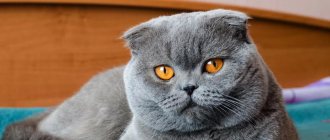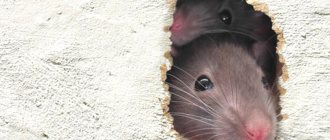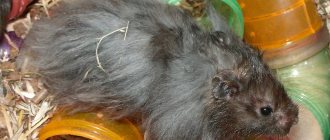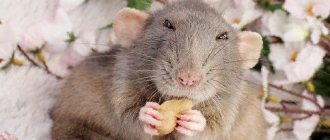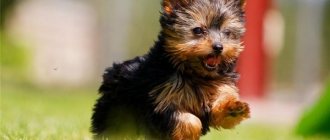There is a whole family of small rodents commonly kept as pets. Some of them are quite easy to tame and enjoy interacting with, while others are more timid.
Some are more active at night, which may not suit some people's lifestyles. However, they are fairly easy animals if you provide them with adequate housing, exercise and food.
If you're looking for a small, furry companion, here are the 10 best small rodents to choose from.
Tip: Many pet rodents are quite fragile animals. Teach anyone who will interact with your pet, especially young children, to be especially gentle and careful.
Family Hedgehogs
The species composition of this family is not the largest. However, 24 different species are known.
All Ezhovs have a number of characteristics that unite them into one family. These include a pointed, elongated muzzle, well-developed eyes and ears, and limbs with five fingers. A distinctive feature of the family is the skin with many needles interspersed with hairs of wool. These rodents also have a special muscle that runs through their entire body. She helps the animal curl up into a ball, escaping from predators.
The habitat of hedgehogs is Central and South Asia, Europe. They were once introduced to islands near Africa, where they spread safely.
Hedgehog
Clawed (Mongolian) gerbil
The gerbil looks like a mouse with a tassel on its tail. They are noticeably different in size from hamsters. Male gerbils can reach a length of 20 cm. It is curious that in captivity, males behave more friendly than females, while females are more active.
In the wild, gerbils live in groups consisting of one male and 2-3 females. Females and males care for the cubs together, however, as soon as the babies grow up, the parents “drive” them away from their territory.
On a note! The best food for gerbils is specially formulated mixtures for rodents. Cabbage, peas, potatoes, sour or too sweet fruits are strictly prohibited. Sometimes protein is added to the diet (egg whites, beetle larvae).
Family Mole rats
Mole rats are burrowing animals that are adapted to life underground. The family is divided into three subfamilies, which include more than 30 species of rodents.
Characteristic features of animals of this family are half-blind eyes, underdeveloped ears, short thick fur, and short limbs. The length of the body of various species can be from 0.13 to 0.48 m, and weigh from 100 g to 4 kg. Some species have powerful incisors with which they dig the ground. Other rodents use their front paws for this.
Mole rats live in Europe, Asia, and northeast Africa. They are also found on Russian territory.
Small bamboo rat
Lesser mole rat
Squirrel family
The family is divided into 5 subfamilies containing approximately 230 species. The most famous are the squirrel and the gopher.
Rodents of this family are widespread on all continents with the exception of Australia and Antarctica. A number of Arctic and tropical islands are also not inhabited by Squirrels.
These rodents can be small or large. Body length varies between 6-70 cm. Weight ranges from a few grams to 9 kg. All have a long tail covered with fur. Squirrels have strong, developed limbs and large eyes. The hair color can have stripes, spots or be one color: red, black, white, etc.
Chipmunk squirrel
prairie dog
Magellan tuco-tuco
Little chipmunk
Little gopher
Palm squirrel
African dormouse
It is a rare pet that can compete in agility and agility with the African dormouse. This animal is considered very active and restless even by rodent standards, so you can keep it in an apartment only if you can provide it with complete safety. There are known cases when animals ran away even from seemingly completely impregnable cages, hiding from their owners throughout the apartment for days.
Therefore, African dormice are often recommended to be kept in a terrarium with a well-closed lid. The diet of these animals is noticeably different from the menu of other rodents. While hamsters, mice and guinea pigs base their menu on plant foods, African dormouse prefer food of animal origin - small insects, mealworms, eggs. However, plant foods cannot be completely excluded from the diet.
How to choose a rodent for an adult?
Before purchasing a rodent for home keeping, there are several factors to consider:
- Apartment size. It should be clear that you cannot bring a large pet into a small apartment, but on the contrary, you can.
- Price. Before you get a rodent, you need to calculate the approximate cost of keeping it so that there are no unwanted surprises later.
- Possible difficulties. Animals should not be owned by people who do not need unnecessary problems and troubles around the house. For example, regular hair removal or cage cleaning.
- Allergy test. You need to find out if someone is allergic, so as not to get into an unpleasant situation.
- Lifestyle. Rodents are mostly nocturnal animals. We must honestly answer the question: “Will this stop me?”
In conclusion, it must be said that each person selects an animal to suit his lifestyle and temperament. Who, no matter how small a creature, will instill love and make you smile?
Syrian (golden) hamster
Syrian, also known as golden, or Western Asian hamsters are small animals with a length of 13 to 14 cm, of which approximately 1.5 cm is in the tail. Weight – 100-125 g. They are omnivores, in natural conditions they feed on seeds, nuts and some insects (ants, flies, wasps, cockroaches). In captivity they can live up to 3-4 years. The color can be golden, white, black, silver or brown.
A solitary animal that does not require a partner for communication, but easily finds a common language with its owner.
Domesticated rat
Unlike their wild ancestors, modern domesticated rats are practically not afraid of people and willingly make contact. These are smart animals with a calm and “non-conflict” character.
Like any social creatures, they require constant communication, so in the absence of a “companion” they may begin to experience psychological stress. However, as practice shows, rats very quickly find a common language with humans and, if the latter pays enough attention to the animal, it becomes a faithful and devoted pet.
Angora rabbit
Angora rabbit
These rabbits were imported from Poland. Their colors vary. What’s interesting about rabbits is their “clothing”: up to 30 days, rabbits look like “ugly ducklings”, and by the 50th day they become “beautiful swans”. You should not breed those rabbits that have poor head pubescence. The rabbit must be constantly combed with a brush and cut out the rolled fur.
Interesting: The largest lakes in Russia - list, names, area, depth, photos and videos
How to choose a rodent for a child?
In order to instill a love for small creatures, children are often given rodents as pets. But before purchasing a pet, you must take into account the age of the child. It is important to remember that under 3 years of age no animals should be owned under any circumstances, since at this time the baby is actively learning about the world around him and can cause significant harm. For example, he will show unwanted care by feeding the animal food that is dangerous for it. To prevent this from happening, parents need to raise their child more strictly, explaining what is good and what is bad. From about 5 years old, you can think about buying a pet rodent.
Family Jerboa
These rodents live in desert, semi-desert, steppe, and low mountain areas. They inhabited northern Africa, some parts of Europe, Asia, Kazakhstan, southern Siberia, etc.
These mammals have a short body, elongated hind legs, and short forelimbs, with which they remove the earth dug out with their incisors. The size of these rodents is 4-25 cm, weight no more than 300 g. All species have a very long tail, which serves as a rudder and balancer when running. These animals have a short neck, a large head, long rounded ears and a uniform skin of beige-brown shades.
Jerboas, with rare exceptions, are nocturnal. They dig burrows, feed on plants and insects, and bear offspring one to three times a year.
Small jerboa
Desert jerboa
Small rodents
Mice
It should be borne in mind that these are herd animals, so it is better to keep several individuals. If this is not possible, you need to arrange the cage in such a way as to prevent your pet from getting bored - for example, install a running wheel. Mice are easy to care for, but do not live long - about 2 years. They are omnivores, but you cannot overfeed them, otherwise it will harm your health. The main disadvantage of mice is their pungent odor, but this disappears with regular cleaning of the cage.
Rats
Rats are very smart animals. They are friendly, quickly get used to new conditions, and can also remember some commands. With proper care they live 2-3 years. Just like mice, they are omnivores. Rats are active - it is important to let them walk outside the cage. If you want to have this pet, you need to be absolutely sure that the animal will be given a lot of attention, otherwise it will not survive. The disadvantages also include a strong smell, but with good cleaning it quickly disappears.
Gerbil
It is better to keep such mice in families - loneliness can lead to illness. They are clean, peaceful, and easy to train. The length of the gerbil reaches 20 cm, and their color is light sandy. Since mice are very active, a running wheel should be placed in the cage. Gerbils love to grind their teeth - disinfected twigs and pieces of wood will do. They practically do not smell - the cage should not be washed more often than once every 2 weeks. They live 2-4 years, but sometimes the age can reach 6 years.
Hamsters
The most common breed of rodent suborder is the Djungarian hamster. These are nocturnal animals whose peak activity occurs at night. Hamsters are quite aggressive - it is dangerous to add a cage mate to them, otherwise everything will end badly. It will take a long time to tame the pet; in the worst case, it will bite painfully. They do not live long - maximum 2-3 years. They require a little attention and eat special food. There is no need to skimp on the things you need to keep your pet. Standard set: cage, food bowl, water bowl, house, running wheel, food.
Guinea pigs
Features of caring for a guinea pig depend on its breed. They are quite affectionate and non-aggressive, often becoming attached to their owner. They are unpretentious in home care - you will need a spacious cage, corn filler, a drinking tube, and bowls. Since the body of pigs does not produce vitamin C, which is necessary for the immune system, it is necessary to buy vitamins containing ascorbic acid. The average lifespan is 5-8 years, but there are also those who reach 15 years. It is recommended to walk with the animal in the fresh air. They are herbivores, so they should be given hay and dry food for food.
Squirrels
A common breed of domestic squirrel is the Veksha. You need to purchase a spacious cage for the animal with several floors. There must be a running wheel to expend energy reserves. It is better to feed such pets with nuts, fresh fruits, mushrooms, and grain food. They need to get a dose of calcium and phosphorus, which are lacking in the body. Squirrels are clean, so you need to clean the cage no more than 1-2 times a week. If you want to start mating these animals, it is better to do this from one year old. With proper care, the lifespan reaches 10 years, rarely 16.
Degu
The breed has two different names - Chilean squirrel and bush rat. They should be kept in a cage with a dense lattice or in a terrarium. The cage is equipped with a wooden house, a wheel and an entertainment area for the animal. Degus feed on fresh greens, fruits, plant seeds, and in winter, hay. Giving sugar is strictly forbidden, since animals are intolerant to it. It is better to keep them in pairs - loneliness has a bad effect on their health. It is important to keep the animal away from sweets and flowers - this is dangerous for it. Lives on average up to 9 years.
Chipmunks
Chipmunks belong to the squirrel family. The cage for the animal should be large and with all the amenities. It must be borne in mind that chipmunks do not get along well together, so they cannot be kept in pairs. They eat almost everything: fruits, plants, fish, insects, etc. These rodents are quite affectionate, but will bite hard if you touch their belly or tail. Life expectancy is up to 8 years. In winter, they sleep more often, without leaving the house for a long time. They tolerate heat very poorly - if the temperature is above 27 C, they can die.
Jerboa
There are more than 25 species of jerboas. The rodent needs to be kept in a spacious enclosure so that it moves a lot. The cage should not be filled with hay - only with coarse sand. They eat vegetables and fruits, as well as various insects. These are clean animals, so cleaning the cage once a week will be enough. They cannot be kept in pairs - this will lead to fights. They lead a predominantly nocturnal lifestyle. With proper care they live for about 4-5 years.
Sonya
A common breed is the hazel dormouse. To maintain a house, a large enclosure with a suitable landscape is suitable: moss, peat, branches. It is necessary to take care of a place for hibernation - it can be an artificial hole or a small pipe. Dormouses feed on what grows on trees: seeds, nuts, small insects. Their peak activity occurs at night, so it is better to remove the cage from the bedroom. They quickly get used to their hands and remember their nicknames. It is not recommended to let him out for a walk around the house - he will hide in some crevice. Life expectancy is 4-5 years.
Life style
Probably the most important thing is that your future pet matches your lifestyle (are you a homebody or, on the contrary, like to travel). The animal is completely dependent on you, so if your work involves constant business travel, it is better not to take an animal.
Another important factor that is worth paying attention to is your attitude towards household chores. Let's face it: Almost every animal leaves a lot of trash . Animals molt, fur and feathers must be collected with a vacuum cleaner, and scales must be swept away. It is necessary to regularly clean litter boxes, cages, and aquariums.
If you like a clean, hassle-free home but want a pet, consider getting a gerbil, fish, or small bird that will happily live in a small cage or aquarium.
Large rodents
Hedgehog
Features of caring for a hedgehog directly depend on its breed. These pets are not picky about home conditions - a large cage and a house with a feeder will be enough. Filler, for example, cat litter, is poured onto the bottom. There is no need to clean it more than 1-2 times a week so as not to frighten the animal. The hedgehog is active at night, but this can be corrected - it is enough to feed him during the day so that he gets used to this routine. A hedgehog's normal diet consists of worms, insects and light meat, as well as dairy products. They live for about 10 years.
Chinchilla
These are affectionate animals with good intelligence. The main advantage is that chinchillas do not have an unpleasant odor or skin diseases. They are herbivores, so they should be fed with special food, herbs, dried fruits and berries. A large cage with a designated area for a nest is suitable as a house. It is necessary to maintain the temperature around 18-20 C; an increase can be dangerous. You cannot wash your chinchilla, otherwise the fur will mat. They live up to 14 years with proper care.
Hare
A hare should not be picked up from the forest unless it is certain that it will remain for a long time. It is not recommended to keep it at home as it is a wild animal. However, if a bunny comes into the house, it should be fed with dog or cat milk substitutes. From a certain age, include greens, fruits, and vegetables in your diet. You need to keep it in an enclosure, periodically letting it out for a walk under supervision. In captivity they live up to 12 years.
Rabbit
It is better to have a short-haired rabbit. They are quiet animals that do not need to be walked regularly. At home, the rabbit is kept in a medium-sized terrarium or cage with hay or sawdust. It is necessary to monitor a comfortable temperature, since they do not tolerate heat and hypothermia well. Acceptable - 18-20 C. To prevent an unpleasant odor in the cage, you need to clean it regularly using disinfectants. The main diet is mixed feed, hay and clean water. Life expectancy is up to 12 years.
Gopher
It is not recommended to keep a gopher in an apartment due to the very strong smell; a spacious enclosure on the territory of a private house is better. Special products are needed to clean it. These are herd animals, so they will not live long alone. Food for gophers is available at the pet store, and you can also give them greens, fruits, and some flowers. The lifespan of the animal is 3-4 years.
Marmot
It has several names - boibak or steppe marmot. A wide cage with strong bars and bars is suitable as a house for an animal. It should not be placed in a cramped room with electrical appliances. These are restless and active rodents, so it is better not to leave them unattended to avoid chaos in the house. They eat mostly ordinary fruits and vegetables; exotic ones should not be given. The bowl should be removed immediately after eating so that the groundhog does not drop it. These animals live up to 15-18 years.
Ferret
The ferret, a type of forest ferret, is suitable for home keeping. These rodents quickly adapt to their surroundings. Caring for them is not very difficult, but it will require a lot of money. It is recommended to seal all cracks in the apartment to prevent the ferret from chewing through anything. It is better for him to live in a spacious enclosure, a separate room or on a loggia with insulation. Feed with special food, vitamins, and sometimes mouse carcasses. A big plus is that ferrets can be owned by people with allergies, since their fur does not cause reactions. The main disadvantage is the unpleasant odor from the fur. They live up to 7-9 years.
Nutria
The animal loves warmth, so during the cold season you cannot keep it in an open cage - this is dangerous. The temperature should not be lower than -15 C. It would be correct to organize a pond in the yard for nutria, where the pet will sunbathe. Favorite delicacies are branches, plants, various shellfish. Compound feed can only be fed in a soaked form. The cage should be cleaned regularly to avoid a strong smell. Nutria live up to 6-7 years.
prairie dog
Prairie dogs belong to the squirrel family. Keeping them at home is not easy, because they are not a hamster or a rat, but a wild animal. An aquarium or a large cage where the rodent can dig its holes is suitable as a house. These are heat-loving creatures, for which a comfortable temperature should be above 17 C. The main diet is hay of various types. Taming a prairie dog will be difficult and requires patience. Respiratory tract diseases to which there is a predisposition should not be allowed. With good care they live up to 7-8 years.
Family Gilts
Gilts live exclusively in South America in its most diverse climatic zones.
Representatives of this family have an elongated body, four-toed forelimbs and three-toed hind limbs, a short tail and neck, and a large head. Ears may be short, long, or absent altogether. The hairline is usually rough. The fur on the back is brown, gray, black or olive. The belly is light: color from white to dark yellow. Some species are nocturnal, others diurnal. However, none of them hibernate.
The family consists of 5 genera, which are represented by 15 species.
Abyssinian guinea pig
Peruvian guinea pig
Brazilian pig
Guinea pig
Decorative mouse
Decorative mice are, in essence, distant relatives of the well-known house mice (yes, the same ones that have the habit of settling not far from human homes and often “peeping into the light” of country houses in the autumn-winter period).
The only difference between such mice and their wild relatives is their colors - they are not found in nature.
Mice are social animals, so it is best to keep them in pairs or groups consisting of only females. Males will almost certainly not be able to live with each other.


